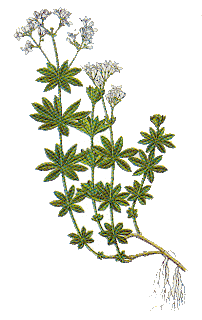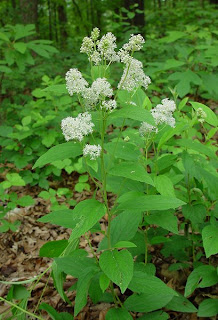WOODRUFF

Latin Name: Asperula odorata
Alternate Names: Sweet Woodruff, Musk Of The Woods
Family: RUBIACEAE
Parts Used: Above ground portion.
Properties: Anodyne, Anti-inflammatory, Antispasmodic, Cardiotonic, Carminative, Diaphoretic, Diuretic, Digestive Tonic, Liver Tonic, Sedative.
Internal Uses: Bladder Stones, Digestive Weakness, Dysmenorrhea, Hysteria, Insomnia, Jaundice, Menopause, Migraine, Phlebitis, Pulmonary Edema, Restlessness, Varicose Veins
Internal Applications: Tea, Tincture, Capsules.
It is a mild sedative that helps regulate heartbeat.
It is a mild sedative that helps regulate heartbeat.
Topical Uses: Boils, Insect Repellent, Wounds
Topical Applications: Poultice of bruised leaves is applied to boils and wounds as an anticoagulant. Used as perfume, potpourri and insect repellent. Used in snuffs.
Culinary uses: Leaves are picked a few hours prior to use to allow the flavor to develop, and then added to cakes, soups, sauces, sorbets, fruit salads, May wine (Maibowle), punches and liqueurs.
Chemical Constituents: Coumarinic compounds that release coumarin as the plant breaks down, iridoids (asperuloside, monotropein), anthraquinones, flavonoids, organic acids (citric, rubichloric), tannin.
Contraindications: Large doses may cause dizziness, possible internal bleeding, and vomiting. Avoid if using blood-thinning medications. Avoid during pregnancy.
Comments: Woodruff was called Wudurofe, from wudu, meaning 'woods' and rove, most likely from the French rouvelle, or 'wheel' in reference to the whorl of leaves surrounding the stem. When dried, Woodruff becomes delightfully scented, similar to newly cut grass, vanilla and honey. It was a popular strewing herb during the Middle Ages. When mixed with animal fodder, it gives cow's milk a delicious aroma.
The common name Woodruff includes the species Galium odoratum, which is used interchangeably with Asperula odorata.
The common name Woodruff includes the species Galium odoratum, which is used interchangeably with Asperula odorata.

